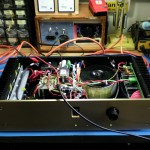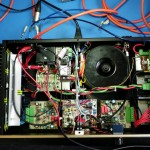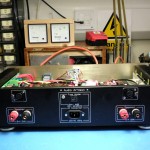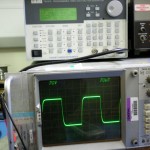Well, the Cordell low distortion oscillator worked a treat! It didn’t work right away: I left a connection out of the PCB. And then I didn’t have a TL074 chip, so I tried a LMC660, and the chip blew up for some reason, which had me puzzled.
(I just checked the LMC660 datasheet: It’s specified for 15V total supply voltage. I fed it +/-16, a total of 32V. Whoops.)
Then, Cordell’s schematic calls for a 2N4091 JFET, a device with a high Idss and low on-resistance, but I couldn’t find any of those. I tried a BF245C, but it wasn’t strong enough. The AGC loop just whacked the gate as far positive as it could go, trying to turn the JFET “more than full on”. So I kept adding more of the things in parallel, until I saw the AGC go negative by a volt or two. I ended up with 5 of them, bodged onto a piece of stripboard.
A J111 would probably have been a better choice. These are the ones Douglas Self recommends as analog switches in “Self On Audio”, and they have a similar 30 ohm Rds(on). JFETs are so variable, though, you never know what you’ll get.
Frequency control with the “Blue Velvet” pot works great! There’s no noticeable amplitude bounce. Well, except for the fact that it’s backwards: anticlockwise to increase. I couldn’t see any easy way to dismantle the pot and reverse the action.
And, first time on the distortion analyser: 0.0015% at 1kHz! 🙂 That’s better than the analyser’s own spec.
Stay tuned as we post some pics and stuff the thing into the spare bay of the DA4084.






